2022 CHRYSLER PACIFICA Vehicle weight
[x] Cancel search: Vehicle weightPage 266 of 384
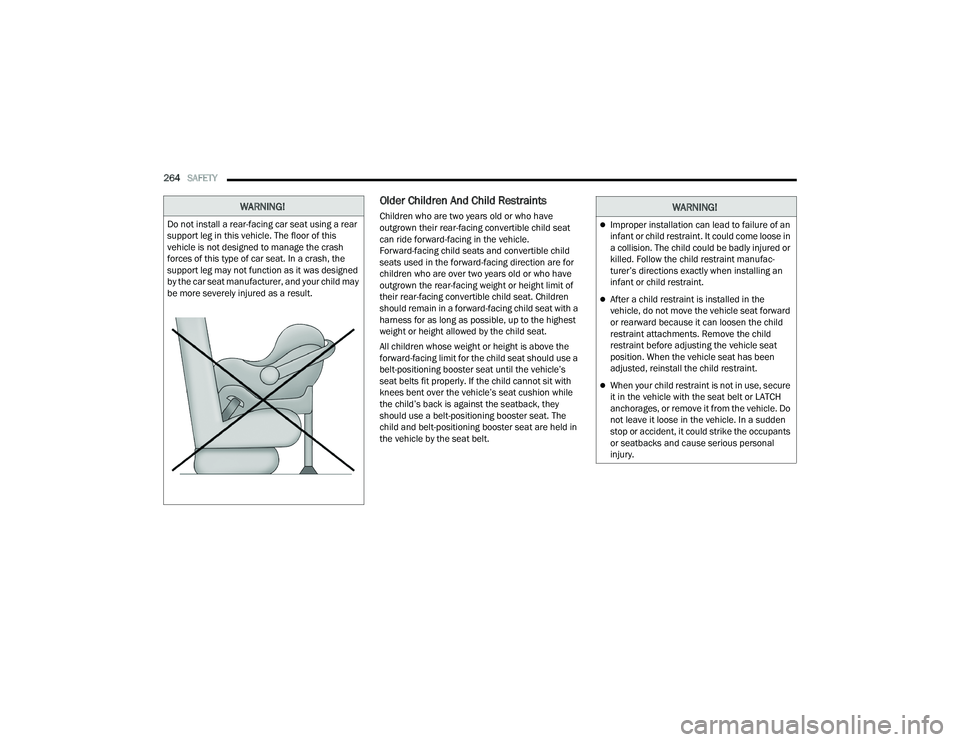
264SAFETY
Older Children And Child Restraints
Children who are two years old or who have
outgrown their rear-facing convertible child seat
can ride forward-facing in the vehicle.
Forward-facing child seats and convertible child
seats used in the forward-facing direction are for
children who are over two years old or who have
outgrown the rear-facing weight or height limit of
their rear-facing convertible child seat. Children
should remain in a forward-facing child seat with a
harness for as long as possible, up to the highest
weight or height allowed by the child seat.
All children whose weight or height is above the
forward-facing limit for the child seat should use a
belt-positioning booster seat until the vehicle’s
seat belts fit properly. If the child cannot sit with
knees bent over the vehicle’s seat cushion while
the child’s back is against the seatback, they
should use a belt-positioning booster seat. The
child and belt-positioning booster seat are held in
the vehicle by the seat belt.WARNING!
Do not install a rear-facing car seat using a rear
support leg in this vehicle. The floor of this
vehicle is not designed to manage the crash
forces of this type of car seat. In a crash, the
support leg may not function as it was designed
by the car seat manufacturer, and your child may
be more severely injured as a result.
WARNING!
Improper installation can lead to failure of an
infant or child restraint. It could come loose in
a collision. The child could be badly injured or
killed. Follow the child restraint manufac -
turer’s directions exactly when installing an
infant or child restraint.
After a child restraint is installed in the
vehicle, do not move the vehicle seat forward
or rearward because it can loosen the child
restraint attachments. Remove the child
restraint before adjusting the vehicle seat
position. When the vehicle seat has been
adjusted, reinstall the child restraint.
When your child restraint is not in use, secure
it in the vehicle with the seat belt or LATCH
anchorages, or remove it from the vehicle. Do
not leave it loose in the vehicle. In a sudden
stop or accident, it could strike the occupants
or seatbacks and cause serious personal
injury.
22_RUP_OM_EN_USC_t.book Page 264
Page 268 of 384
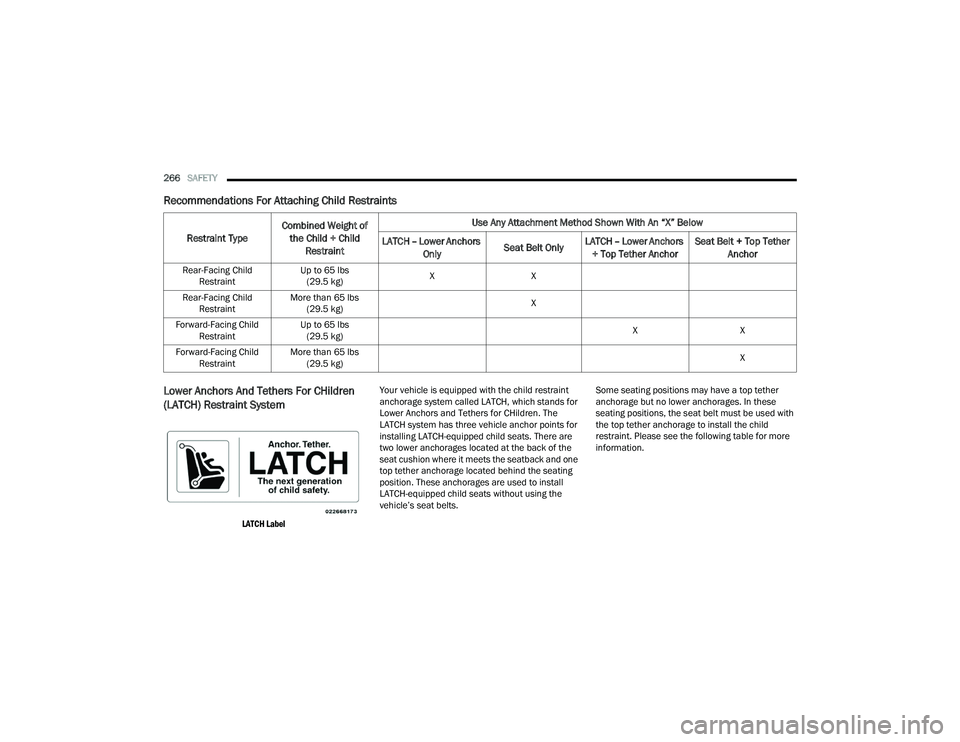
266SAFETY
Recommendations For Attaching Child Restraints
Lower Anchors And Tethers For CHildren
(LATCH) Restraint System
LATCH Label
Your vehicle is equipped with the child restraint
anchorage system called LATCH, which stands for
Lower Anchors and Tethers for CHildren. The
LATCH system has three vehicle anchor points for
installing LATCH-equipped child seats. There are
two lower anchorages located at the back of the
seat cushion where it meets the seatback and one
top tether anchorage located behind the seating
position. These anchorages are used to install
LATCH-equipped child seats without using the
vehicle’s seat belts.
Some seating positions may have a top tether
anchorage but no lower anchorages. In these
seating positions, the seat belt must be used with
the top tether anchorage to install the child
restraint. Please see the following table for more
information.
Restraint Type
Combined Weight of
the Child + Child Restraint Use Any Attachment Method Shown With An “X” Below
LATCH – Lower Anchors Only Seat Belt Only LATCH – Lower Anchors
+ Top Tether Anchor Seat Belt + Top Tether
Anchor
Rear-Facing Child Restraint Up to 65 lbs
(29.5 kg) X
X
Rear-Facing Child Restraint More than 65 lbs
(29.5 kg) X
Forward-Facing Child Restraint Up to 65 lbs
(29.5 kg) X
X
Forward-Facing Child Restraint More than 65 lbs
(29.5 kg) X
22_RUP_OM_EN_USC_t.book Page 266
Page 270 of 384
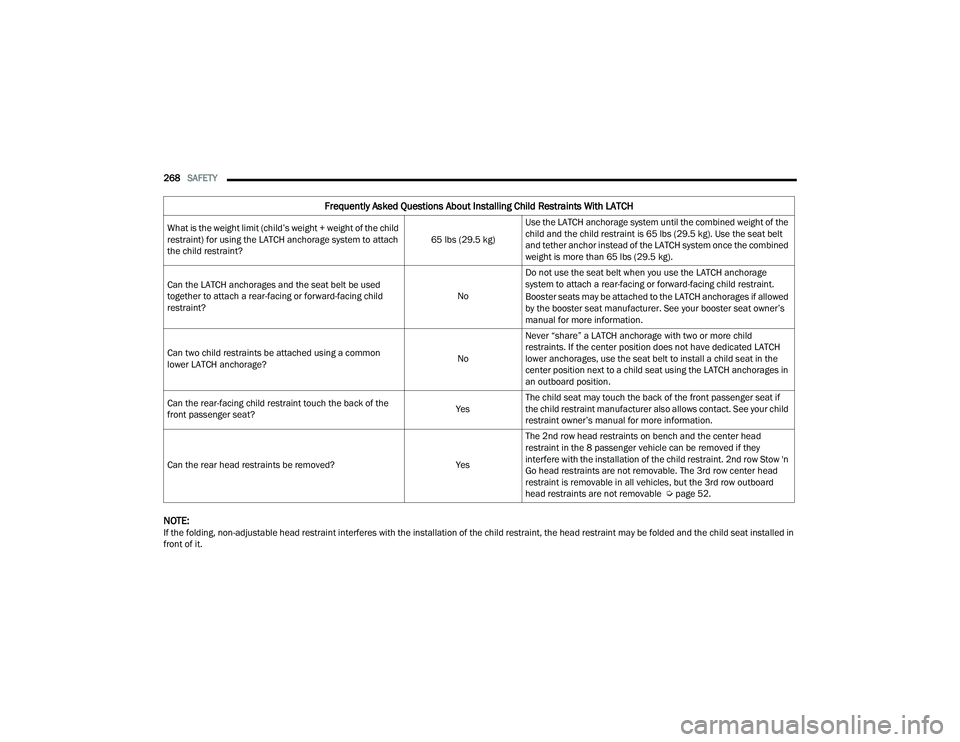
268SAFETY
NOTE:If the folding, non-adjustable head restraint interferes with the installation of the child restraint, the head restraint may be folded and the child seat installed in
front of it.
Frequently Asked Questions About Installing Child Restraints With LATCH
What is the weight limit (child’s weight + weight of the child
restraint) for using the LATCH anchorage system to attach
the child restraint? 65 lbs (29.5 kg)Use the LATCH anchorage system until the combined weight of the
child and the child restraint is 65 lbs (29.5 kg). Use the seat belt
and tether anchor instead of the LATCH system once the combined
weight is more than 65 lbs (29.5 kg).
Can the LATCH anchorages and the seat belt be used
together to attach a rear-facing or forward-facing child
restraint? NoDo not use the seat belt when you use the LATCH anchorage
system to attach a rear-facing or forward-facing child restraint.
Booster seats may be attached to the LATCH anchorages if allowed
by the booster seat manufacturer. See your booster seat owner’s
manual for more information.
Can two child restraints be attached using a common
lower LATCH anchorage? NoNever “share” a LATCH anchorage with two or more child
restraints. If the center position does not have dedicated LATCH
lower anchorages, use the seat belt to install a child seat in the
center position next to a child seat using the LATCH anchorages in
an outboard position.
Can the rear-facing child restraint touch the back of the
front passenger seat? YesThe child seat may touch the back of the front passenger seat if
the child restraint manufacturer also allows contact. See your child
restraint owner’s manual for more information.
Can the rear head restraints be removed? YesThe 2nd row head restraints on bench and the center head
restraint in the 8 passenger vehicle can be removed if they
interfere with the installation of the child restraint. 2nd row Stow 'n
Go head restraints are not removable. The 3rd row center head
restraint is removable in all vehicles, but the 3rd row outboard
head restraints are not removable Ú
page 52.
22_RUP_OM_EN_USC_t.book Page 268
Page 276 of 384
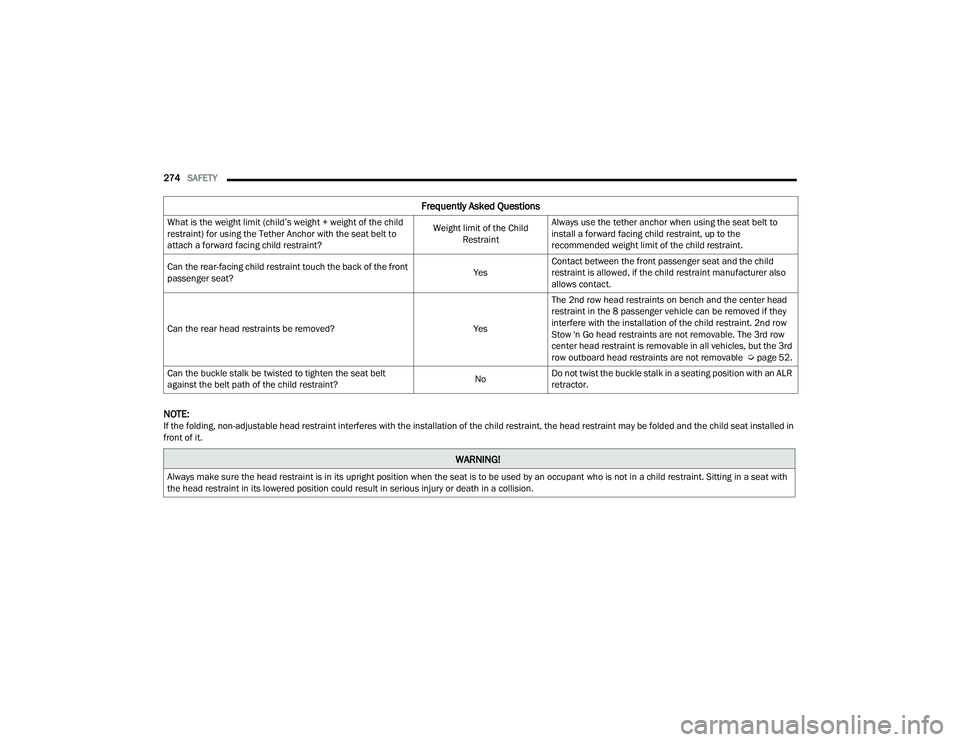
274SAFETY
NOTE:If the folding, non-adjustable head restraint interferes with the installation of the child restraint, the head restraint may be folded and the child seat installed in
front of it.
Frequently Asked Questions
What is the weight limit (child’s weight + weight of the child
restraint) for using the Tether Anchor with the seat belt to
attach a forward facing child restraint? Weight limit of the Child
Restraint Always use the tether anchor when using the seat belt to
install a forward facing child restraint, up to the
recommended weight limit of the child restraint.
Can the rear-facing child restraint touch the back of the front
passenger seat? YesContact between the front passenger seat and the child
restraint is allowed, if the child restraint manufacturer also
allows contact.
Can the rear head restraints be removed? YesThe 2nd row head restraints on bench and the center head
restraint in the 8 passenger vehicle can be removed if they
interfere with the installation of the child restraint. 2nd row
Stow 'n Go head restraints are not removable. The 3rd row
center head restraint is removable in all vehicles, but the 3rd
row outboard head restraints are not removable Ú
page 52.
Can the buckle stalk be twisted to tighten the seat belt
against the belt path of the child restraint? NoDo not twist the buckle stalk in a seating position with an ALR
retractor.
WARNING!
Always make sure the head restraint is in its upright position when the seat is to be used by an occupant who is not in a child restraint. Sitting in a seat with
the head restraint in its lowered position could result in serious injury or death in a collision.
22_RUP_OM_EN_USC_t.book Page 274
Page 345 of 384
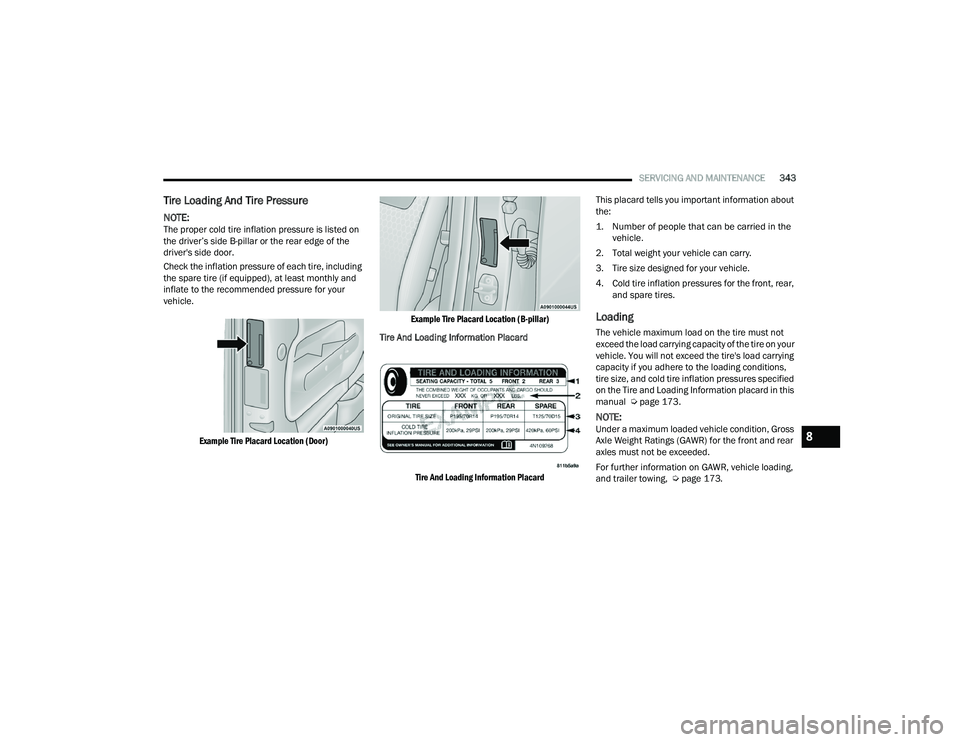
SERVICING AND MAINTENANCE343
Tire Loading And Tire Pressure
NOTE:The proper cold tire inflation pressure is listed on
the driver’s side B-pillar or the rear edge of the
driver's side door.
Check the inflation pressure of each tire, including
the spare tire (if equipped), at least monthly and
inflate to the recommended pressure for your
vehicle.
Example Tire Placard Location (Door) Example Tire Placard Location (B-pillar)
Tire And Loading Information Placard
Tire And Loading Information Placard
This placard tells you important information about
the:
1. Number of people that can be carried in the
vehicle.
2. Total weight your vehicle can carry.
3. Tire size designed for your vehicle.
4. Cold tire inflation pressures for the front, rear, and spare tires.
Loading
The vehicle maximum load on the tire must not
exceed the load carrying capacity of the tire on your
vehicle. You will not exceed the tire's load carrying
capacity if you adhere to the loading conditions,
tire size, and cold tire inflation pressures specified
on the Tire and Loading Information placard in this
manual Ú page 173.
NOTE:Under a maximum loaded vehicle condition, Gross
Axle Weight Ratings (GAWR) for the front and rear
axles must not be exceeded.
For further information on GAWR, vehicle loading,
and trailer towing, Ú page 173.8
22_RUP_OM_EN_USC_t.book Page 343
Page 346 of 384
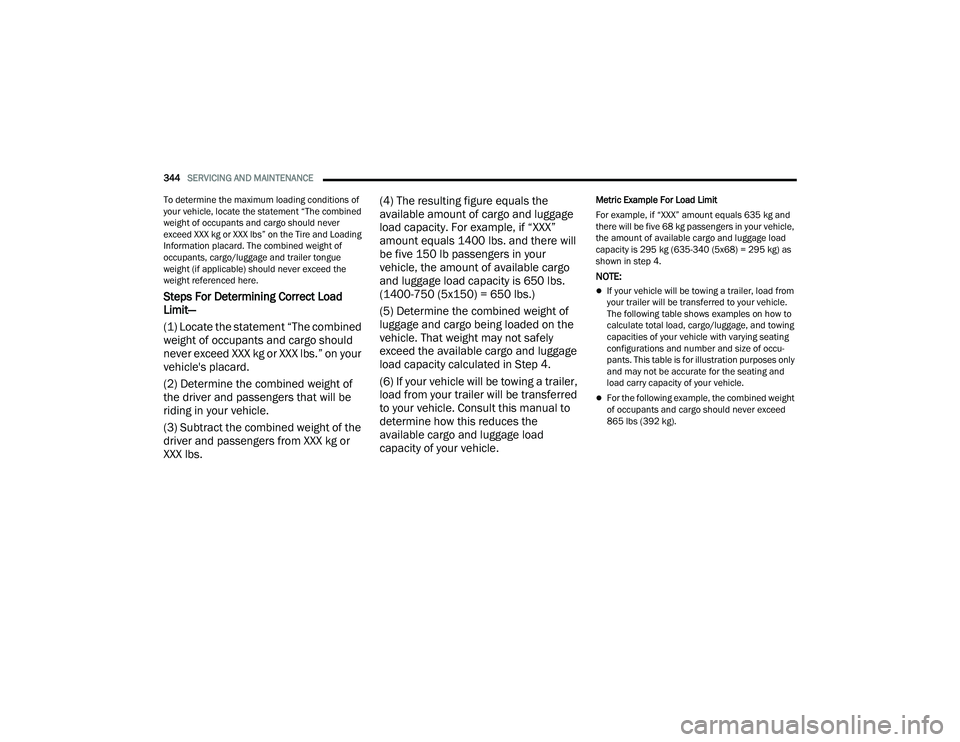
344SERVICING AND MAINTENANCE
To determine the maximum loading conditions of
your vehicle, locate the statement “The combined
weight of occupants and cargo should never
exceed XXX kg or XXX lbs” on the Tire and Loading
Information placard. The combined weight of
occupants, cargo/luggage and trailer tongue
weight (if applicable) should never exceed the
weight referenced here.
Steps For Determining Correct Load
Limit—
(1) Locate the statement “The combined
weight of occupants and cargo should
never exceed XXX kg or XXX lbs.” on your
vehicle's placard.
(2) Determine the combined weight of
the driver and passengers that will be
riding in your vehicle.
(3) Subtract the combined weight of the
driver and passengers from XXX kg or
XXX lbs. (4) The resulting figure equals the
available amount of cargo and luggage
load capacity. For example, if “XXX”
amount equals 1400 lbs. and there will
be five 150 lb passengers in your
vehicle, the amount of available cargo
and luggage load capacity is 650 lbs.
(1400-750 (5x150) = 650 lbs.)
(5) Determine the combined weight of
luggage and cargo being loaded on the
vehicle. That weight may not safely
exceed the available cargo and luggage
load capacity calculated in Step 4.
(6) If your vehicle will be towing a trailer,
load from your trailer will be transferred
to your vehicle. Consult this manual to
determine how this reduces the
available cargo and luggage load
capacity of your vehicle.
Metric Example For Load Limit
For example, if “XXX” amount equals 635 kg and
there will be five 68 kg passengers in your vehicle,
the amount of available cargo and luggage load
capacity is 295 kg (635-340 (5x68) = 295 kg) as
shown in step 4.
NOTE:
If your vehicle will be towing a trailer, load from
your trailer will be transferred to your vehicle.
The following table shows examples on how to
calculate total load, cargo/luggage, and towing
capacities of your vehicle with varying seating
configurations and number and size of occu
-
pants. This table is for illustration purposes only
and may not be accurate for the seating and
load carry capacity of your vehicle.
For the following example, the combined weight
of occupants and cargo should never exceed
865 lbs (392 kg).
22_RUP_OM_EN_USC_t.book Page 344
Page 376 of 384

374 Oil Filter
..................................................... 316Oil Selection.................................... 315, 364Oil Synthetic.............................................. 316Overheating............................................... 303Starting..................................................... 131Enhanced Accident Response
Feature................................................ 260, 308Ethanol.......................................................... 362Exhaust Gas Cautions.................................... 281Exhaust System................................... 281, 323Exterior Lighting...................................... 65, 338Exterior Lights...................... 65, 281, 337, 338
F
FiltersAir Cleaner
................................................. 316Air Conditioning.................................. 83, 318Engine Oil........................................ 316, 365Engine Oil Disposal................................... 316FireTV............................................................ 218FlashersHazard Warning......................................... 282Turn Signals.................... 65, 128, 281, 338Flash-To-Pass........................................... 65, 67Flat Tire Changing....................... 286, 339, 350Flat Tire Stowage........................ 294, 339, 350Flooded Engine Starting................................ 134
Fluid Capacities............................................ 364Fluid Leaks................................................... 281Fluid Level ChecksBrake........................................................ 327Engine Oil................................................. 314Fluid, Brake.................................................. 366Fog Lights................................................. 65, 68Fold In Floor (Stow ‘n Go) Seating.................... 42Fold-Flat Seats................................................. 33Forward Collision Warning............................ 233Freeing A Stuck Vehicle................................ 305Front Position Light....................................... 338Fuel............................................................... 361Additives................................................... 363Clean Air................................................... 361Ethanol..................................................... 362Filler Cap (Gas Cap).................................. 172Gasoline................................................... 361Materials Added....................................... 363Methanol.................................................. 362Octane Rating.................................. 361, 365Requirements........................................... 361Specifications........................................... 365Tank Capacity........................................... 364Fuses............................................................ 329
G
Garage Door Opener (HomeLink).....................61Gas Cap (Fuel Filler Cap)............................... 172Gasoline, (Fuel)............................................. 361Gasoline, Clean Air........................................ 361Gasoline, Reformulated................................ 361Gear Ranges................................................. 141Glass Cleaning.............................................. 359Gross Axle Weight Rating.............................. 175Gross Vehicle Weight Rating......................... 174GVWR............................................................ 173
H
HazardDriving Through Flowing, Rising, Or Shallow Standing Water
................... 186Hazard Warning Flashers.............................. 282Head Restraints...............................................52Headlights........................................................65Cleaning.................................................... 357High Beam/Low Beam Select Switch..........65Lights On Reminder..............................65, 67Passing.................................................65, 67Switch..........................................................65Time Delay...................................................65Washers.......................................................67
22_RUP_OM_EN_USC_t.book Page 374
Page 381 of 384

379
Specifications Oil
.............................................................. 365Speed ControlAccel/Decel (ACC Only)............................. 151Cancel....................................................... 147Resume..................................................... 147Speed Control (Cruise Control)...................... 147Starting................................................... 19, 131Button......................................................... 18Cold Weather............................................ 134Engine Fails To Start................................. 134Remote....................................................... 19Starting And Operating.................................. 131Starting Procedures....................................... 131Steering......................................................... 143Tilt Column.................................................. 31Wheel, Heated............................................. 31Wheel, Tilt................................................... 31Storage, Vehicle............................................... 83Stow ‘n Go (Fold In Floor) Seats....................... 42Stow ‘n Vac.................................................... 100Streaming...................................................... 213Stuck, Freeing............................................... 305Sun Roof................................................... 94, 96Sunglasses Storage......................................... 84Supplemental Restraint System – Air Bag..... 251Sway Control, Trailer...................................... 229Symbol Glossary.............................................. 10
Synthetic Engine Oil...................................... 316System, Remote Starting................................. 19
T
Telescoping Steering Column.......................... 31Temperature Control, Automatic (ATC)............. 82Tie Down Hooks, Cargo................................. 100Tilt Steering Column........................................ 31Time DelayHeadlight..................................................... 65Tire And Loading Information Placard........... 343Tire Markings................................................ 339Tire Safety Information................................. 339Tire Service Kit.............................................. 294Tire Service Kit — If Equipped
b
................ 294Tire Stowage................................................. 294Tires......................... 280, 346, 350, 351, 355Aging (Life Of Tires).................................. 349Air Pressure.............................................. 346Chains...................................................... 353Changing.................................................. 286Compact Spare......................................... 351General Information............... 346, 350, 351High Speed............................................... 347Inflation Pressure..................................... 347Jacking............................................ 286, 288Life Of Tires.............................................. 349
Load Capacity........................................... 343Pressure Monitoring System (TPMS)................................116, 126, 236Quality Grading......................................... 355Radial....................................................... 347Replacement............................................ 349Rotation.................................................... 355Safety.............................................. 339, 346Sizes......................................................... 340Snow Tires................................................ 350Spare Tires................... 287, 350, 351, 352Spinning................................................... 348Trailer Towing........................................... 181Tread Wear Indicators.............................. 348Wheel Nut Torque..................................... 360To Open Hood..................................................96Tongue Weight/Trailer Weight...................... 180Towing........................................................... 174Disabled Vehicle....................................... 306Guide........................................................ 177Recreational............................................. 184Weight...................................................... 177Towing Behind A Motorhome........................ 184Traction......................................................... 185Traction Control............................................ 228Trailer Sway Control (TSC)............................. 229
11
22_RUP_OM_EN_USC_t.book Page 379